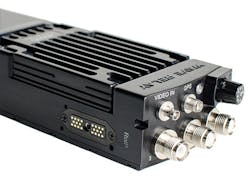Persistent Systems has received a high-level security validation from the National Institute of Standards and Technology (NIST) for its MPU5 networking radio and Embedded Module products. Specifically, it is Federal Information Processing Standards (FIPS) 140-2 security validation, and it allows the MPU5 and other communications products from Persistent Systems to be used by U.S. government agencies requiring a high level of security in their communications.
As an example, with this validation, government users can use the MPU5 radio (see figure) to connect to the Federal Enterprise Network with the assurance that communications are immune to eavesdroppers. The MPU5 radio system operates with the Wave Relay mobile ad-hoc networking (MANET) routing protocol, allowing users to transmit and relay voice, video, text, and data in a peer-to-peer fashion. The Embedded Module delivers secure communications capabilities similar to those of the MPU5 radio, but in a smaller configuration for use as sensors and for integration into unmanned aerial vehicles (UAVs) and unmanned ground vehicles (UGVs).
The MPU5 radio and smaller version, the Embedded Module, have both received FIPS 140-2 security validation from NIST. (Courtesy of Persistent Systems)
“We offer a self-forming, self-healing, scalable MANET that is robust and dynamic and can operate in austere and challenging environments that would normally disrupt other communication systems,” said Eric Stern, director of engineering at Persistent Systems. “This makes the MPU5 and Embedded Module very attractive for government users.”
The MPU5 radio has been used by a number of U.S. government groups, including the Departments of Justice and Homeland Security, but many agencies require a FIPS 140-2 validation. To receive that validation, the MPU5 and the Embedded Module were put through the Cryptographic Module Validation Program (CMVP). The CMVP is a joint initiative between the National Institute of Standards and Technology in the United States and the Communications Security Establishment (CSE) in Canada.
About the Author
Jack Browne
Technical Contributor
Jack Browne, Technical Contributor, has worked in technical publishing for over 30 years. He managed the content and production of three technical journals while at the American Institute of Physics, including Medical Physics and the Journal of Vacuum Science & Technology. He has been a Publisher and Editor for Penton Media, started the firm’s Wireless Symposium & Exhibition trade show in 1993, and currently serves as Technical Contributor for that company's Microwaves & RF magazine. Browne, who holds a BS in Mathematics from City College of New York and BA degrees in English and Philosophy from Fordham University, is a member of the IEEE.


